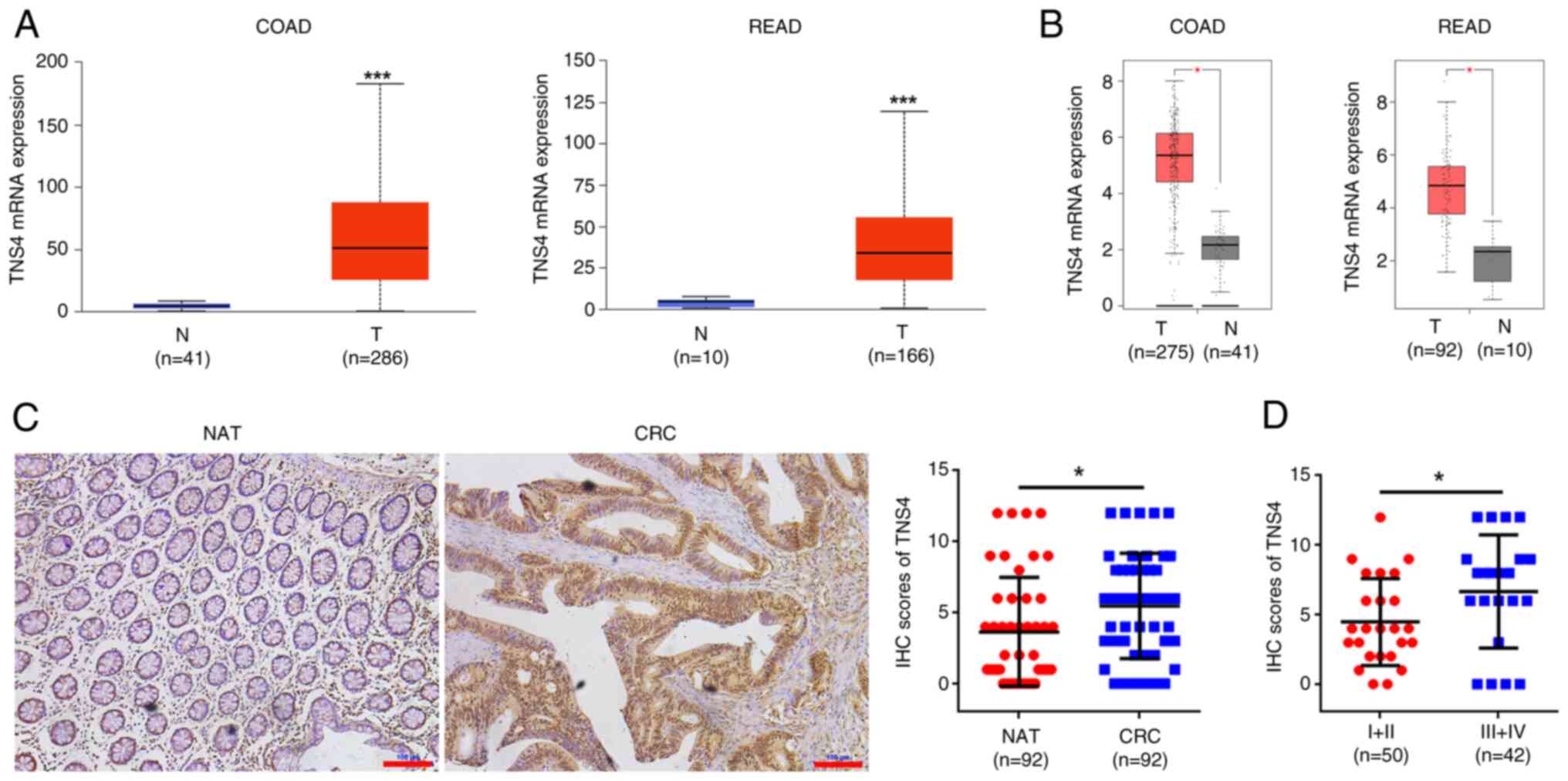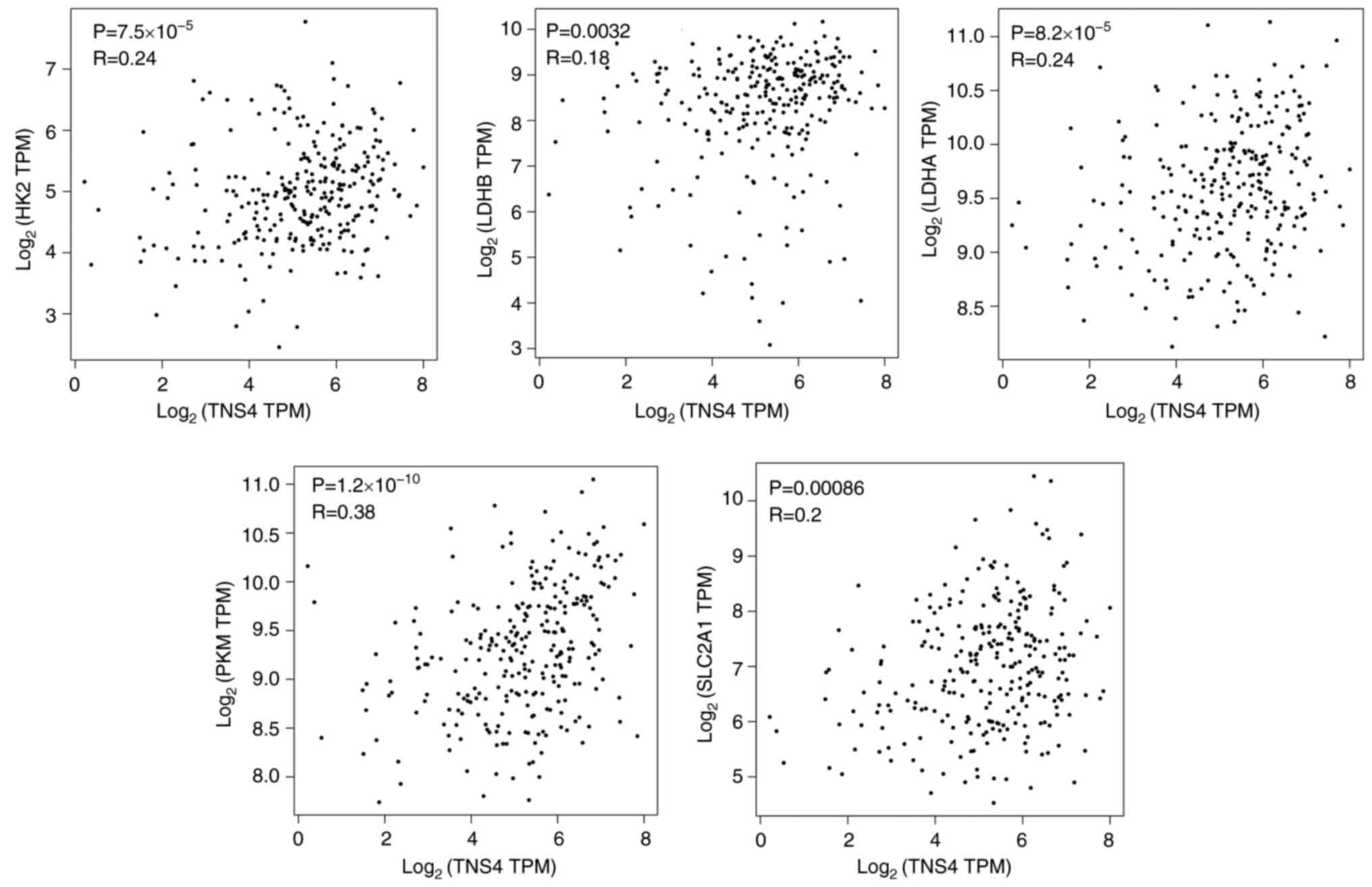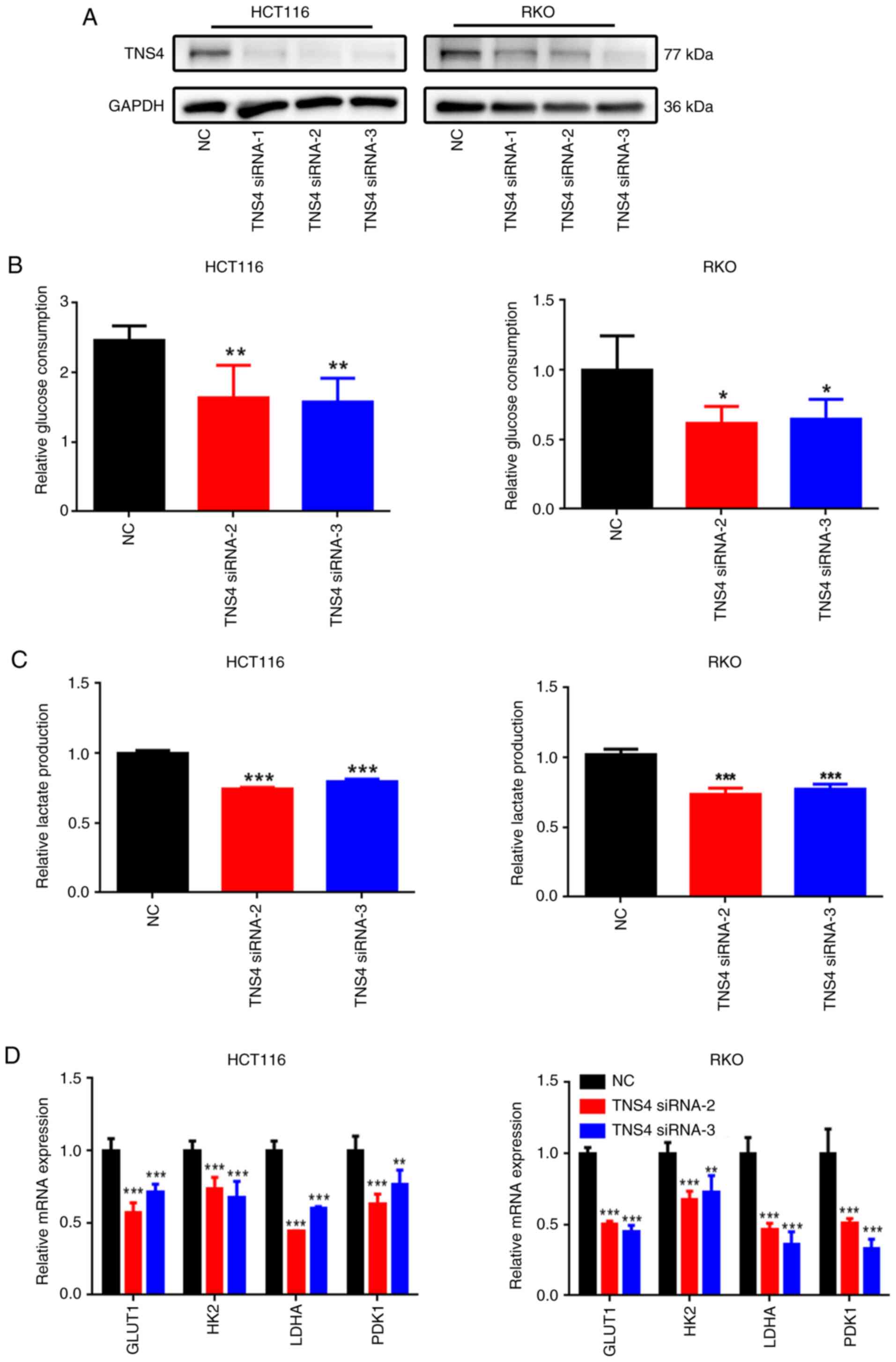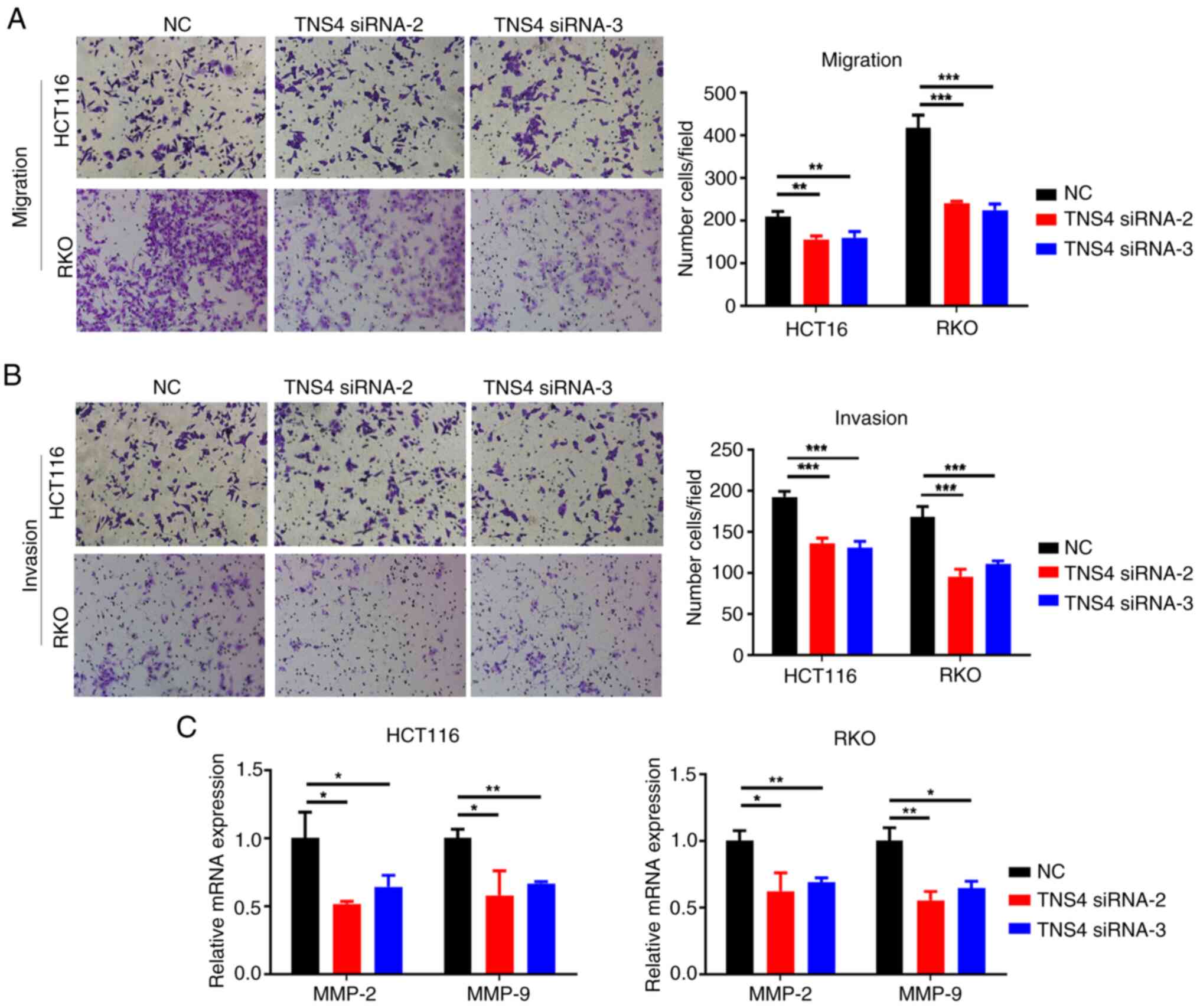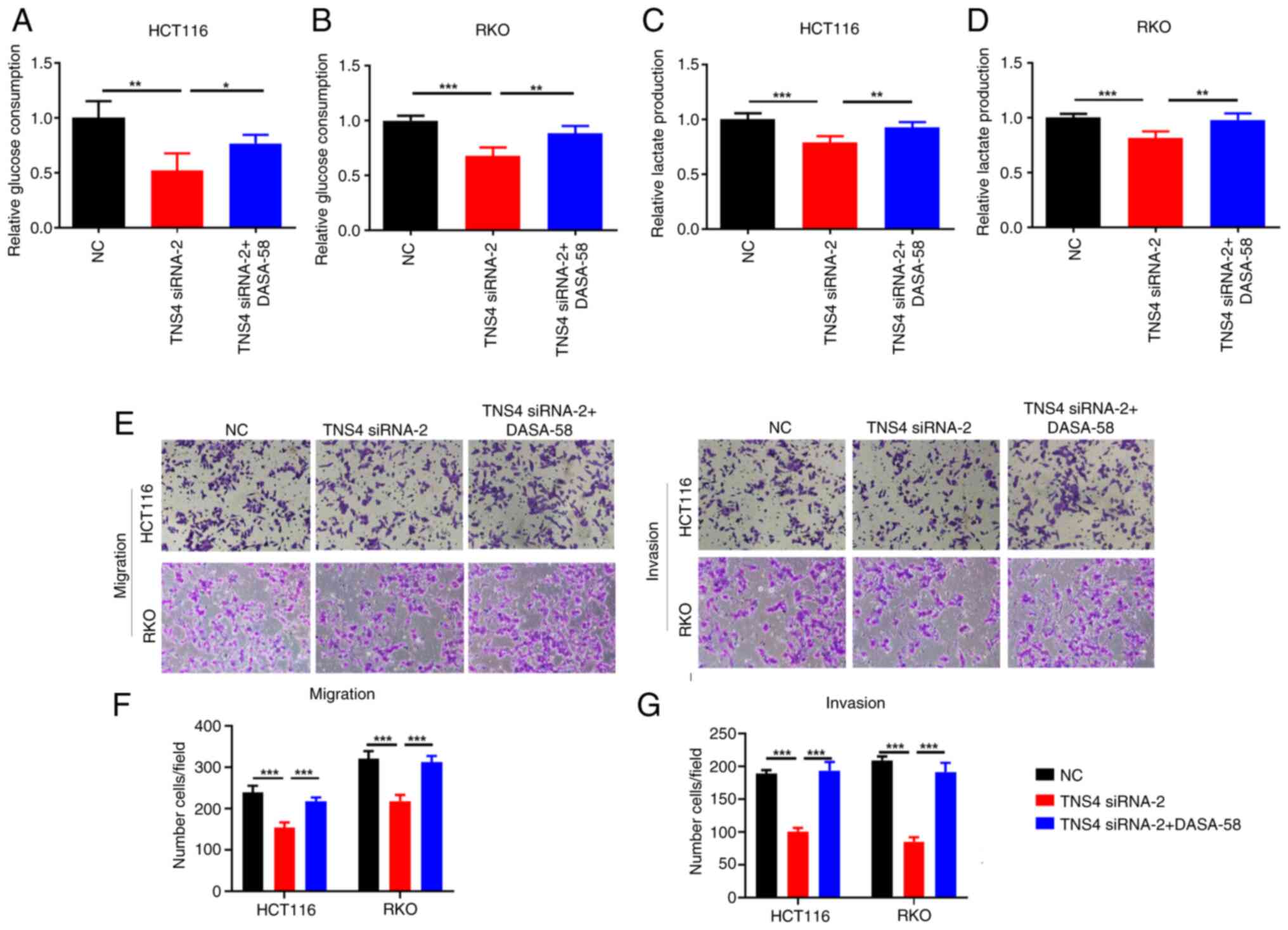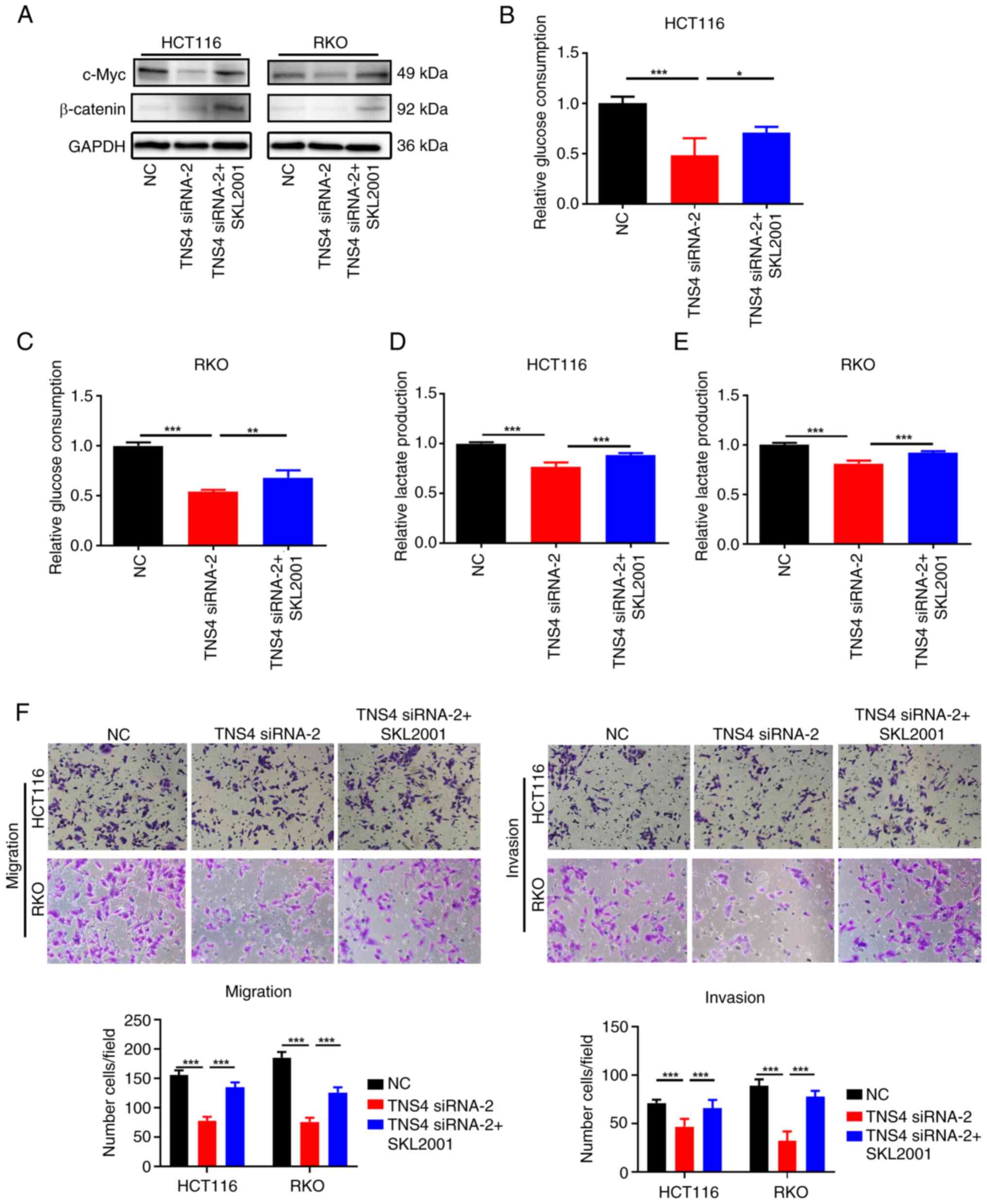Tensin 4 facilitates aerobic glycolysis, migration and invasion of colorectal cancer cells through the β‑catenin/c‑Myc signaling pathway
- Authors:
- Published online on: June 3, 2024 https://doi.org/10.3892/ol.2024.14489
- Article Number: 356
-
Copyright: © Wang et al. This is an open access article distributed under the terms of Creative Commons Attribution License.
Abstract
Introduction
As colorectal cancer (CRC) is one of the most commonly diagnosed malignancies and the leading cause of cancer-related mortality worldwide with >1.85 million cases and 850 000 deaths annually, it has become a major public health concern. In recent years, the 5-year survival rate of patients with CRC has markedly improved with the development of treatment strategies, such as surgery, radiotherapy, chemotherapy and immunotherapy (1,2); however, the effects of the current treatment methods are limited for patients with advanced-stage or metastatic CRC (3). Hence, the identification of novel targets and the further elucidation of the mechanisms underlying the progression of CRC is of utmost urgency.
Tensin 4 (TNS4), also known as COOH-terminal tensin-like, belongs to the tensin focal adhesion family (4). A number of studies have reported that TNS4 is overexpressed in several types of cancer, including breast cancer, pancreatic cancer, lung cancer and CRC (5–8). Furthermore, TNS4 has been reported to be associated with several biological processes, such as epithelial-mesenchymal transition (EMT) (9–11), cell motility (6,12), cell migration (13), metastasis (8) and drug resistance (14,15). For example, TNS4 overexpression promotes EMT, cell motility and the colony formation of CRC cells through Src signaling (9). Liao et al (16) noted that TNS4 interacted with β-catenin in colon cancer cells, which enhanced the colony formation, anchorage-independent proliferation and invasiveness of colon cancer cells.
Aerobic glycolysis, also known as the Warburg effect, is a distinctive hallmark of cancer, which confers a proliferation advantage on cancer cells by providing them with energy and biosynthesis building blocks (17). Accumulating evidence has indicated that targeting or modulating aerobic glycolysis may serve as an antitumor therapeutic strategy (18). For example, a previous study reported that the long non-coding (lnc)RNA AGPG promoted tumor cell glycolysis and the proliferation of esophageal squamous cell carcinoma cells by stabilizing PFKFB3 (19). Furthermore, Yu et al (20) reported that OTU deubiquitinase, ubiquitin aldehyde binding 2 suppressed CRC cell proliferation and migration and promoted apoptosis and sensitivity to chemotherapeutic drugs by regulating pyruvate kinase M (PKM)2 ubiquitination and glycolysis. However, the role of TNS4 in the glycolysis and progression of CRC remains unclear.
The present study aimed to explore the roles of TNS4 in regulating aerobic glycolysis, migration and invasion of CRC cells and investigate the underlying molecular mechanisms.
Materials and methods
Analysis of TNS4 expression in patients with CRC
The expression of TNS4 in patients with colon adenocarcinoma or rectum adenocarcinoma was obtained from the University of Alabama at Birmingham Cancer data analysis Portal (UALCAN; http://ualcan.path.uab.edu/) and Gene Expression Profiling Interactive Analysis (GEPIA; http://gepia.cancer-pku.cn/) databases with data from The Cancer Genome Atlas (TCGA).
Immunohistochemistry
A total of 92 pairs of paraffin blocks of CRC tissues and corresponding normal adjacent tissues were obtained from the First Affiliated Hospital of Soochow University (Suzhou, China). The detailed clinicopathological information of the patients is provided in Table SI. Ethics approval was obtained from the Institutional Review Board of the First Affiliated Hospital of Soochow University and written informed consent was obtained from the patients prior to sample collection. Immunohistochemistry was performed as previously described (21). Briefly, tissues were fixed with 4% paraformaldehyde (Beyotime Institute of Biotechnology) at 25°C for 24 h. The specimens were embedded in paraffin. 5-µm-thick sections from paraffin-embedded blocks were deparaffinized and rehydrated. After antigen retrieval with 10 mM sodium citrate buffer (pH 6.0, Beyotime Institute of Biotechnology), the sections were incubated with 3% hydrogen peroxide at room temperature for 10 min to block endogenous peroxidase activity and non-specific protein interactions. The sections were subsequently incubated with rabbit anti-human TNS4 antibodies (1:200; cat. no. 11580-1-AP; Proteintech Group, Inc.) overnight at 4°C and then with biotinylated goat anti-rabbit secondary antibody working solution (1:500; cat. no. SA1020; Boster Biological Technology Co. Ltd.) at 37°C for 30 min. Subsequently, the immunodetection was performed using the Dako EnVision detection system (Agilent Technologies, Inc.). These slides were photographed under a fluorescence microscope (Leica, Buffalo Grove, USA). The semi-quantitative immunoreactive score system was adopted to obtain the score of TNS4 immunostaining, as previously described (22).
Cells and cell culture
In total, two CRC cell lines (HCT116 and RKO) were purchased from the American Type Culture Collection. Both the HCT116 and RKO cells were cultured in DMEM (Biological Industries; Sartorius AG) containing 10% fetal bovine serum (FBS, Biological Industries; Sartorius AG), 100 U/ml penicillin and 100 mg/ml streptomycin at 37°C in a humidified atmosphere of 5% CO2. The CRC cells were treated with glycolysis activator DASA-58 (5 µM, Selleck) and β-catenin activator SKL2001 (10 µM, Selleck) at 37°C for 48 h.
Cell transfection and infection
In total, three commercial TNS4 small interfering (si)RNAs (TNS4 siRNA-1, TNS4 siRNA-2 and TNS4 siRNA-3) were purchased from Guangzhou RiboBio Co., Ltd. The three pairs of synthesized siRNA sequences were as follows: siRNA-1 forward, 5′-CAAUCAUAGAAGAAGACCATT-3′ and reverse, 5′-UGGUCUUCUUCUAUGAUUGTT-3′; siRNA-2 forward, 5′-GGGCCAUCUCUCUGUGAUUTT-3′ and reverse, 5′-AAUCACAGAGAGAUGGCCCTT-3′; siRNA-3 forward, 5′-GCAAUGACCUCAUCCGACATT-3′ and reverse, 5′-UGUCGGAUGAGGUCAUUGCTT-3′; and siRNA negative control forward, 5′-UUCUCCGAACGUGUCACGUTT-3′ and reverse, 5′-ACGUGACACGUUCGGAGAATT-3′. For cell transfection, the HCT116 or RKO cells were transfected using Lipofectamine 2000® (Invitrogen™; Thermo Fisher Scientific, Inc.) according to the manufacturer's instructions with TNS4 siRNA-1, TNS4 siRNA-2 or TNS4 siRNA-3 (100 pmol) at 37°C for 48 h. Scrambled siRNA negative control (100 pmol) was used. After 48 h post-transfection, the cells were harvested for RNA extraction and reverse transcription (RT)-quantitative (q)PCR and Western blot. Besides, after 6 h of transfection, the cells were used for Transwell analysis, glucose consumption and lactate production assay.
TNS4 siRNA-3 had the highest inhibition efficiency of TNS4 in HCT116 and RKO cells. Lentivirus pGLVU6/Puro vectors carrying TNS4 shRNA containing the sequence of TNS4 siRNA-3 or siRNA negative control sequence were manufactured using the 2nd generation system by GenePharma Co., Ltd. The lentiviral TNS4 shRNA plasmid (8 µg) was co-transfected with psPAX2 (2 µg, cat. no. 12260; Addgene, Inc.) and pMD2.G (6 µg, cat. no. 12259; Addgene, Inc.) in HEK293T cells (American Type Culture Collection) in 10 cm-culture dish at 37° for 10 h. After replacing the transfection medium using the culture medium, lentiviral particles in the culture medium was collected every day for 3 days. For cell transduction, the HCT116 and RKO cells in the logarithmic growth period were infected with lentiviral particles (multiplicity of infection=20) at 37°C for 12 h. The transfection efficiency was observed under a fluorescence microscope at 24 h after transfection After 72 h infection, puromycin (1 µg/ml, Beyotime Institute of Biotechnology) was added to screen for stable TNS4 knockdown and negative control cell lines. The screening period is about 8 to 12 days. The stable cells were cultured in complete medium with 0.5 µg/ml puromycin at 37°C.
RNA extraction and reverse transcription (RT)-quantitative (q)PCR
Total RNA extraction from HCT116 and RKO cells was performed using the Cell Total RNA Kit (cat. no. ES-RN001, Shanghai Yishan Biotechnology Co., Ltd.). Subsequently, 1.0 µg total RNA was used for cDNA synthesis using the RTIII AII-in-One Mix (cat. no. MR05101, Monad Biotech Co., Ltd.) with the following conditions: 37°C for 2 min, 55°C for 15 min, and 85°C for 5 min. RT-qPCR was performed using the CFX96 Touch Real-Time PCR Detection System (Bio-Rad Laboratories, Inc.) using the ChemoHS qPCR Mix (cat. no. MQ00401, Monad Biotech Co., Ltd.) with SYBR Green. The cycling conditions were as follows: one cycle at 95°C for 5 min, 40 cycles of amplification at 95°C for 10 sec, and 60°C for 30 sec. RT-qPCR was performed three times for each sample. β-actin was used for the normalization of gene expression. All primers used for RT-qPCR are listed in Table SII.
Western blot analysis
The HCT116 and RKO cells were lysed using RIPA buffer containing protease inhibitors and phosphatase inhibitors (cat. no. P0013D; Beyotime Institute of Biotechnology). The Enhanced BCA Protein Assay kit (cat. no. P0010; Beyotime Institute of Biotechnology) was used for protein determination. Subsequently, 10% SDS-PAGE; (cat. no. P0012AC; Beyotime Institute of Biotechnology) was used to separate the total protein (30 µg), which then was transferred onto PVDF membranes (Cytiva). After blocking with 5% BSA (cat. no. FMS-WB021; Nanjing Fcmacs Biotechnology Co., Ltd.) for 1.5 h at room temperature, the membranes were incubated with rabbit anti-human TNS4 (1:1,000; cat. no. 11580-1-AP; Proteintech Group, Inc.) or mouse anti-human/mouse GAPDH (1:1,000; cat. no. 60004-1-Ig; Proteintech Group, Inc.) antibodies at 4°C overnight. The membranes were then incubated with the corresponding HRP-conjugated goat anti-rabbit (1:1,000; cat. no. A0208; Beyotime Institute of Biotechnology) or anti-mouse secondary antibodies (1:1,000; cat. no. A0216; Beyotime Institute of Biotechnology) for 1 h at room temperature. Finally, the protein bands were visualized using an ECL reagent (cat. no. 10100; NCM Biotech) in a ChemiDoc™ MP Imaging System (Bio-Rad Laboratories, Inc.). Additionally, ImageJ 2.0 software (National Institutes of Health) was used to analyze the density of the protein bands.
Cell migration and invasion assay
To assess CRC cell migration and invasion, a Transwell chamber was purchased from BD Biosciences (cat. no. 353097) and Matrigel from Corning, Inc. (cat. no. 356234). For the cell migration assay, 3×104 HCT116 or RKO cells in serum-free medium (400 µl) were seeded into the upper chamber (8-µm pore size). Complete medium containing with 10% FBS was added to the lower chamber. For the invasion assay, Matrigel (200 µg/ml) was used to coat the upper chamber at room temperature for 2 h. For migration or invasion, after cultured in the upper chamber for 24 h or 48 h, the cells on the lower surface of the upper chamber were fixed with 4% paraformaldehyde (Beyotime Institute of Biotechnology) at room temperature for 30 min and stained with crystal violet (Beyotime Institute of Biotechnology) at room temperature for 15 min. Images were captured using a Nikon Eclipse/NI-U fluorescence microscope and the number of migrated/invaded cells was counted.
Glucose consumption and lactate production assay
A Glucose Assay kit (cat. no. 361510; Shanghai Robio Biotechnology Co., Ltd.) and a Lactate Assay kit (cat. no. A019-2-1; Nanjing Jiancheng Taihao Biotechnology Co., Ltd.) were used for the detection of glucose consumption and lactate production according to the manufacturer's protocols, respectively.
Statistical analysis
Data are presented as the mean ± standard deviation. GraphPad Prism 6.0 software (Dotmatics) was used for statistical analyses. The paired or unpaired Student's t-test, or one-way ANOVA and Tukey's test's, were used to analyze the data. P<0.05 was considered to indicate a statistically significant difference.
Results
TNS4 is highly expressed in clinical CRC tissue and is associated with the TNM stage of patients with CRC
To assess the role of TNS4 in CRC, its expression was evaluated in the tissues of patients with CRC. The mRNA levels of TNS4 were significantly upregulated in both colon and rectal cancer tissues compared with normal tissues, according to data from the UALCAN and GEPIA databases (Fig. 1A and B). Furthermore, a CRC tumor cohort was used to assess the protein expression of TNS4. Compared with the normal control, the tumor tissues exhibited a significantly higher protein expression of TNS4 (Fig. 1C). Moreover, TNS4 expression in patients with late-stage (III–IV) disease was significantly higher than that in patients with early-stage (I–II) disease (Fig. 1D). These data suggest that TNS4 may function as an oncogene in CRC.
TNS4 is positively correlated with glycolysis-related genes in patients with CRC
The GEPIA database was used to further evaluate the association between TNS4 and glycolysis in CRC. It was demonstrated that there were significant positive correlations between TNS4 expression and glycolysis-related genes, such as hexokinase 2 (HK2), lactate dehydrogenase (LDH)B, LDHM, pyruvate kinase M1/2 (PKM) and solute carrier (SLC)2A1, in the cancer tissues of patients with CRC (Fig. 2). These data indicate that TNS4 may function as a key regulator of glycolysis in CRC.
TNS4 knockdown inhibits glucose consumption and lactate production in CRC cells
To assess the potential role of TNS4 in glycolysis in CRC cells, TNS4 was knocked down in the HCT116 and RKO cell lines by transfecting them with three non-overlapping TNS4 siRNAs (TNS4 siRNA-1, TNS4 siRNA-2 and TNS4 siRNA-3). Compared with NC, transfection with TNS4 siRNA-1, TNS4 siRNA-2 and TNS4 siRNA-3 markedly decreased the protein expression of TNS4 in the HCT116 and RKO cells (Fig. 3A). Moreover, TNS4 knockdown significantly decreased glucose consumption and lactate production in the HCT116 and RKO cells compared with NC (Fig. 3B and C). Compared with NC, TNS4 silencing also led to a significant decrease in the mRNA expression of multiple glycolysis-related genes, including glucose transporter 1, HK2, LDHA and pyruvate dehydrogenase kinase 1 in the CRC cells (Fig. 3D).
TNS4 silencing attenuates the migration and invasion of CRC cells
The present study assessed whether TNS4 knockdown regulated the migration and invasion of CRC cells. Compared with the control group, the migration and invasion of the HCT116 and RKO cells was significantly decreased in the TNS4 knockdown groups (Fig. 4A and B). Furthermore, transfection with TNS4 siRNA-2 and TNS4 siRNA-3 significantly downregulated the mRNA expression of matrix metallopeptidase (MMP)-2 and MMP-9 in the HCT116 and RKO cells (Fig. 4C). These data suggest that TNS4 may serve a critical role in the migration and invasion of CRC cells.
TNS4 silencing inhibits CRC cell migration and invasion via glycolysis
Previous studies have demonstrated that the activation of glycolysis serves a key role in the migration and invasion of cancer cells (23,24). As TNS4 knockdown significantly suppressed the glycolysis, migration and invasion of CRC cells in the present study, the ability of TNS4 to modulate CRC cell migration and invasion via glycolysis was subsequently evaluated. The results demonstrated that compared with NC, the glucose consumption and lactate production were significantly reduced in HCT116 and RKO cells following TNS4 knockdown, then with the addition of DASA-58, an activator of glycolysis (25), they significantly increased (Fig. 5A-D). Notably, treatment with DASA-58 significantly reversed the effects of TNS4 silencing on the migration and invasion of HCT116 and RKO cells (Fig. 5E-G).
TNS4 knockdown inhibits glycolysis and metastasis of CRC cells via the β-catenin/c-Myc pathway
To evaluate the mechanism of action of TNS4 in the glycolysis and metastasis of CRC cells, a review of the literature was performed. β-catenin/c-Myc signaling has been reported to be involved in regulating both glycolysis and metastasis in cancers (16,26–30). In addition, TNS4 overexpression has been reported to activate β-catenin signaling in colon cancer (16). Therefore, it we hypothesized that TNS4 knockdown suppressed glycolysis, migration and invasion of CRC cells via the β-catenin/c-Myc pathway. The results of western blot analysis revealed that compared with NC, the knockdown of TNS4 markedly reduced the expression of β-catenin and c-Myc in the HCT116 and RKO cells (Fig. 6A). Furthermore, the addition of SKL2001, an activator of β-catenin signaling (31), notably reversed the inhibitory effects of TNS4 knockdown on β-catenin and c-Myc expression in the HCT116 and RKO cells (Fig. 6A). In addition, it was demonstrated that compared with NC, the glucose consumption and lactate production were significantly reduced in HCT116 and RKO cells following TNS4 knockdown, then with the addition of SKL2001, they significantly increased (Fig. 6B-E). Additionally, treatment with SKL2001 significantly increased the migration and invasion of the HCT116 and RKO cells following transfection with TNS4 siRNA-2 (Fig. 6F). These results suggest that TNS4 may promote the glycolysis and metastasis of CRC cells via the β-catenin/c-Myc pathway.
Discussion
There is increasing evidence to indicate that TNS4 is highly expressed in multiple cancer tissues (4). Albasri et al (8) analyzed the expression of TNS4 in a series of 462 patients with CRC using immunohistochemistry and reported that the expression of TNS4 was markedly increased, and was associated with an advanced Dukes' stage, poor prognosis and distant metastasis. In the present study, it was demonstrated that TNS4 mRNA levels were significantly upregulated in CRC tissues according to data from the UALCAN and GEPIA databases. Furthermore, TNS4 protein expression was significantly increased in the tissue samples of patients with CRC and was positively associated with the TNM stage. These results suggest that TNS4 functions as an oncogene and serves critical roles in the progression of CRC. In addition, TNS4 is an important protein involved in maintaining normal cellular functions, particularly those related to cell adhesion, migration and signaling (4,32). However, as the current study focused on the biological functions of TSN4 in CRC, the role of TNS4 in normal cells by knocking down its expression was not assessed. It is important to explore the roles of TNS4 in maintaining the normal structure and function of the kidney and heart, as well as wound regeneration (32).
Previous studies have demonstrated that TNS4 serves a crucial role in the progression of cancer by regulating several biological functions, such as EMT, cell motility, apoptosis and tumorigenicity (4,9). Based on data from TCGA, the present study revealed that the expression of TNS4 was significantly associated with glycolysis-related genes (namely, HK2, LDHB, LDHM, PKM and SLC2A1) in the CRC tissue samples, suggesting that TNS4 may be involved in the regulation of aerobic glycolysis in CRC. Aerobic glycolysis, as a key hallmark of cancer, has been demonstrated to be associated with tumor growth, metastasis and drug resistance in CRC (33,34). Shi et al (21) reported that B7 homolog 3, an immunoregulatory protein, enhanced the chemoresistance of CRC cells by promoting HK2-mediated aerobic glycolysis. Zhao et al (35) reported that lncRNA MIR17HG overexpression resulted in persistent glycolysis and the invasion and liver metastasis of CRC cells. To the best of our knowledge, the present study is the first to demonstrate that TNS4 knockdown significantly inhibits glucose consumption, lactate production and the mRNA expression of multiple glycolysis-related genes in CRC cells. These results suggest that TNS4 is a key regulator of aerobic glycolysis in CRC.
A number of studies have indicated that TNS4 is associated with the metastasis of cancer cells (8,11,36,37). A previous study reported that, in non-small cell lung cancer, TNS4 overexpression induced the EMT process and elevated the migratory capacity of the cells (12). Asiri et al (36) noted that TNS4, as a direct mediator of TGF-β1 signaling, participated in TGF-β1-induced EMT and cell motility in CRC. Moreover, the TNS4-integrin-linked kinase interaction also modulated cell motility in CRC (8). In the present study, it was demonstrated that TNS4 knockdown significantly decreased the migration and invasion of CRC cells. These results suggest that TNS4 exerts promoting effects on the metastasis of CRC cells. Furthermore, aerobic glycolysis is a crucial influencing factor for cancer metastasis (38,39), and in the present study, it was demonstrated that treatment with DASA-58, an activator of glycolysis, significantly reversed the effects of TNS4 silencing on the migration and invasion of CRC cells. These results suggest that the TNS4-induced promotion of the migration and invasion of CRC cells is glycolysis-dependent.
The activation of the β-catenin/c-Myc pathway has been reported to be associated with cancer (29,30). For example, CD36 has been reported to inhibit the glycolysis and tumorigenesis of CRC through the glypican 4-β-catenin-c-Myc signaling axis (40). Liang et al (41) indicated that butyrate controlled gastric cancer cell proliferation, migration, invasion and aerobic glycolysis by downregulating Wnt/β-catenin/c-MYC signaling. In human hepatocellular carcinoma, Gankyrin has been reported to upregulate glycolysis and glutaminolysis to promote tumorigenesis, metastasis and drug resistance via upregulating c-Myc through the activation of β-catenin signaling (26). In the present study, it was revealed that TNS4 knockdown significantly reduced the protein expression of β-catenin and c-Myc in CRC cells. Consistent with these findings, it has been reported that TNS4 can activate the β-catenin pathway to regulate tumorigenicity and tumor angiogenesis (5,16,42). Moreover, SKL2001, an activator of β-catenin signaling, significantly reversed the effects of TNS4 knockdown on glucose consumption, lactate production, and the migration and invasion of CRC cells. Taken together, these results suggest that TNS4 promotes the glycolysis and metastasis of CRC cells through the β-catenin/c-Myc pathway.
In conclusion, the results of the present study demonstrated that TNS4 was highly expressed in CRC tissues, and that its high expression was positively associated with the TNM stages of patients with CRC. Moreover, the silencing of TNS4 inhibited the glycolysis, migration and invasion of CRC cells via the β-catenin/c-Myc pathway. This suggests that TNS4 may be an efficient target for CRC diagnosis and therapy.
Supplementary Material
Supporting Data
Acknowledgements
Not applicable.
Funding
Funding: No funding was received.
Availability of data and materials
The data generated in the present study may be requested from the corresponding author.
Authors' contributions
YW and CX designed the experiments. YW and YL performed the experiments and analyzed the data. YW wrote the manuscript. CX and YL made suggestions during the writing. YW and YL confirm the authenticity of all the raw data. All authors have read and approved the final manuscript.
Ethics approval and consent to participate
The present study was approved by the Ethics Review Board of the First Affiliated Hospital of Soochow University (Suzhou, China; approval no. 2021-327). Written informed consent was obtained from the patients prior to obtaining the samples.
Patient consent for publication
Not applicable.
Competing interests
The authors declare that they have no competing interests.
References
|
Biller LH and Schrag D: Diagnosis and treatment of metastatic colorectal cancer: A review. JAMA. 325:669–685. 2021. View Article : Google Scholar : PubMed/NCBI | |
|
Piawah S and Venook AP: Targeted therapy for colorectal cancer metastases: A review of current methods of molecularly targeted therapy and the use of tumor biomarkers in the treatment of metastatic colorectal cancer. Cancer. 125:4139–4147. 2019. View Article : Google Scholar : PubMed/NCBI | |
|
Holladay L, Luu J, Balendra V and Kmetz K: Current and potential treatment of colorectal cancer metastasis to bone. Cancer Treat Res Commun. 37:1007632023. View Article : Google Scholar : PubMed/NCBI | |
|
Lo SH: C-terminal tensin-like (CTEN): A promising biomarker and target for cancer. Int J Biochem Cell Biol. 51:150–154. 2014. View Article : Google Scholar : PubMed/NCBI | |
|
Lu X, Zhou B, Cao M, Shao Q, Pan Y and Zhao T: CTEN inhibits tumor angiogenesis and growth by targeting VEGFA through down-regulation of β-catenin in breast cancer. Technol Cancer Res Treat. 20:153303382110455062021. View Article : Google Scholar : PubMed/NCBI | |
|
Al-Ghamdi S, Cachat J, Albasri A, Ahmed M, Jackson D, Zaitoun A, Guppy N, Otto WR, Alison MR, Kindle KB and Ilyas M: C-terminal tensin-like gene functions as an oncogene and promotes cell motility in pancreatic cancer. Pancreas. 42:135–140. 2013. View Article : Google Scholar : PubMed/NCBI | |
|
Sasaki H, Moriyama S, Mizuno K, Yukiue H, Konishi A, Yano M, Kaji M, Fukai I, Kiriyama M, Yamakawa Y and Fujii Y: Cten mRNA expression was correlated with tumor progression in lung cancers. Lung Cancer. 40:151–155. 2003. View Article : Google Scholar : PubMed/NCBI | |
|
Albasri A, Al-Ghamdi S, Fadhil W, Aleskandarany M, Liao YC, Jackson D, Lobo DN, Lo SH, Kumari R, Durrant L, et al: Cten signals through integrin-linked kinase (ILK) and may promote metastasis in colorectal cancer. Oncogene. 30:2997–3002. 2011. View Article : Google Scholar : PubMed/NCBI | |
|
Asiri A, Toss MS, Raposo TP, Akhlaq M, Thorpe H, Alfahed A, Asiri A and Ilyas M: Cten promotes epithelial-mesenchymal transition (EMT) in colorectal cancer through stabilisation of Src. Pathol Int. 69:381–391. 2019. View Article : Google Scholar : PubMed/NCBI | |
|
Thorpe H, Asiri A, Akhlaq M and Ilyas M: Cten promotes epithelial-mesenchymal transition through the post-transcriptional stabilization of Snail. Mol Carcinog. 56:2601–2609. 2017. View Article : Google Scholar : PubMed/NCBI | |
|
Lu X, Gao J, Zhang Y, Zhao T, Cai H and Zhang T: CTEN induces epithelial-mesenchymal transition (EMT) and metastasis in non small cell lung cancer cells. PLoS One. 13:e01988232018. View Article : Google Scholar : PubMed/NCBI | |
|
Albasri A, Seth R, Jackson D, Benhasouna A, Crook S, Nateri AS, Chapman R and Ilyas M: C-terminal Tensin-like (CTEN) is an oncogene which alters cell motility possibly through repression of E-cadherin in colorectal cancer. J Pathol. 218:57–65. 2019. View Article : Google Scholar : PubMed/NCBI | |
|
Wang YX, Huang CY, Chiu HJ, Huang PH, Chien HT, Jwo SH and Liao YC: Nuclear-localized CTEN is a novel transcriptional regulator and promotes cancer cell migration through its downstream target CDC27. J Physiol Biochem. 79:163–174. 2023. View Article : Google Scholar : PubMed/NCBI | |
|
Lu X, Zhang Y, Pan Y, Cao M, Zhou X and Zhang T: Overexpression of CTEN is associated with gefitinib resistance in non-small cell lung cancer. Oncol Lett. 21:402021.PubMed/NCBI | |
|
Li Y, Mizokami A, Izumi K, Narimoto K, Shima T, Zhang J, Dai J, Keller ET and Namiki M: CTEN/tensin 4 expression induces sensitivity to paclitaxel in prostate cancer. Prostate. 70:48–60. 2010. View Article : Google Scholar : PubMed/NCBI | |
|
Liao YC, Chen NT, Shih YP, Dong Y and Lo SH: Up-regulation of C-terminal tensin-like molecule promotes the tumorigenicity of colon cancer through beta-catenin. Cancer Res. 69:4563–4566. 2009. View Article : Google Scholar : PubMed/NCBI | |
|
Schwartz L, Supuran CT and Alfarouk KO: The Warburg effect and the hallmarks of cancer. Anticancer Agents Med Chem. 17:164–170. 2017. View Article : Google Scholar : PubMed/NCBI | |
|
Zhong X, He X, Wang Y, Hu Z, Huang H, Zhao S, Wei P and Li D: Warburg effect in colorectal cancer: The emerging roles in tumor microenvironment and therapeutic implications. J Hematol Oncol. 15:1602022. View Article : Google Scholar : PubMed/NCBI | |
|
Liu J, Liu ZX, Wu QN, Lu YX, Wong CW, Miao L, Wang Y, Wang Z, Jin Y, He MM, et al: Long noncoding RNA AGPG regulates PFKFB3-mediated tumor glycolytic reprogramming. Nat Commun. 11:15072020. View Article : Google Scholar : PubMed/NCBI | |
|
Yu S, Zang W, Qiu Y, Liao L and Zheng X: Deubiquitinase OTUB2 exacerbates the progression of colorectal cancer by promoting PKM2 activity and glycolysis. Oncogene. 41:46–56. 2022. View Article : Google Scholar : PubMed/NCBI | |
|
Shi T, Ma Y, Cao L, Zhan S, Xu Y, Fu F, Liu C, Zhang G, Wang Z, Wang R, et al: B7-H3 promotes aerobic glycolysis and chemoresistance in colorectal cancer cells by regulating HK2. Cell Death Dis. 10:3082019. View Article : Google Scholar : PubMed/NCBI | |
|
Liu M, Huang F, Zhang D, Ju J, Wu XB, Wang Y, Wang Y, Wu Y, Nie M, Li Z, et al: Heterochromatin protein HP1gamma promotes colorectal cancer progression and is regulated by miR-30a. Cancer Res. 75:4593–4604. 2015. View Article : Google Scholar : PubMed/NCBI | |
|
Chen Z, Hu Z, Sui Q, Huang Y, Zhao M, Li M, Liang J, Lu T, Zhan C, Lin Z, et al: LncRNA FAM83A-AS1 facilitates tumor proliferation and the migration via the HIF-1α/glycolysis axis in lung adenocarcinoma. Int J Biol Sci. 18:522–535. 2022. View Article : Google Scholar : PubMed/NCBI | |
|
Lin S, Li Y, Wang D, Huang C, Marino D, Bollt O, Wu C, Taylor MD, Li W, DeNicola GM, et al: Fascin promotes lung cancer growth and metastasis by enhancing glycolysis and PFKFB3 expression. Cancer Lett. 518:230–242. 2021. View Article : Google Scholar : PubMed/NCBI | |
|
Rao J, Wang H, Ni M, Wang Z, Wang Z, Wei S, Liu M, Wang P, Qiu J, Zhang L, et al: FSTL1 promotes liver fibrosis by reprogramming macrophage function through modulating the intracellular function of PKM2. Gut. 71:2539–2550. 2022. View Article : Google Scholar : PubMed/NCBI | |
|
Liu R, Li Y, Tian L, Shi H, Wang J, Liang Y, Sun B, Wang S, Zhou M, Wu L, et al: Gankyrin drives metabolic reprogramming to promote tumorigenesis, metastasis and drug resistance through activating β-catenin/c-Myc signaling in human hepatocellular carcinoma. Cancer Lett. 443:34–46. 2019. View Article : Google Scholar : PubMed/NCBI | |
|
Dai M, Song J, Wang L, Zhou K and Shu L: HOXC13 promotes cervical cancer proliferation, invasion and Warburg effect through β-catenin/c-Myc signaling pathway. J Bioenerg Biomembr. 53:597–608. 2021. View Article : Google Scholar : PubMed/NCBI | |
|
Liu Y, Huang Y, Zhang J, Pei C, Hu J, Lyu J and Shen Y: TIMMDC1 knockdown inhibits growth and metastasis of gastric cancer cells through metabolic inhibition and AKT/GSK3β/β-catenin signaling pathway. Int J Biol Sci. 14:1256–1267. 2018. View Article : Google Scholar : PubMed/NCBI | |
|
Rennoll S and Yochum G: Regulation of MYC gene expression by aberrant Wnt/β-catenin signaling in colorectal cancer. World J Biol Chem. 6:290–300. 2015. View Article : Google Scholar : PubMed/NCBI | |
|
Ashihara E, Takada T and Maekawa T: Targeting the canonical Wnt/β-catenin pathway in hematological malignancies. Cancer Sci. 106:665–671. 2015. View Article : Google Scholar : PubMed/NCBI | |
|
Wu YB, Li SY, Liu JY, Xue JJ, Xu JF, Chen T, Cao TY, Zhou H, Wu TT, Dong CL, et al: Long non-coding RNA NRSN2-AS1 promotes ovarian cancer progression through targeting PTK2/β-catenin pathway. Cell Death Dis. 14:6962023. View Article : Google Scholar : PubMed/NCBI | |
|
Liao YC and Lo SH: Tensins-emerging insights into their domain functions, biological roles and disease relevance. J Cell Sci. 134:jcs2540292021. View Article : Google Scholar : PubMed/NCBI | |
|
Zafari N, Velayati M, Damavandi S, Pourali G, Mobarhan MG, Nassiri M, Hassanian SM, Khazaei M, Ferns GA and Avan A: Metabolic pathways regulating colorectal cancer: A potential therapeutic approach. Curr Pharm Des. 28:2995–3009. 2022. View Article : Google Scholar : PubMed/NCBI | |
|
Nenkov M, Ma Y, Gaßler N and Chen Y: Metabolic reprogramming of colorectal cancer cells and the microenvironment: Implication for therapy. Int J Mol Sci. 22:62622021. View Article : Google Scholar : PubMed/NCBI | |
|
Zhao S, Guan B, Mi Y, Shi D, Wei P, Gu Y, Cai S, Xu Y, Li X, Yan D, et al: LncRNA MIR17HG promotes colorectal cancer liver metastasis by mediating a glycolysis-associated positive feedback circuit. Oncogene. 40:4709–4724. 2021. View Article : Google Scholar : PubMed/NCBI | |
|
Asiri A, Raposo TP, Alfahed A and Ilyas M: TGFβ1-induced cell motility but not cell proliferation is mediated through Cten in colorectal cancer. Int J Exp Pathol. 99:323–330. 2018. View Article : Google Scholar : PubMed/NCBI | |
|
Fleming JC, Woo J, Moutasim K, Hanley CJ, Frampton SJ, Wood O, Ward M, Woelk CH, Ottensmeier CH, Hafizi S, et al: CTEN induces tumour cell invasion and survival and is prognostic in radiotherapy-treated head and neck cancer. Cancers (Basel). 12:29632020. View Article : Google Scholar : PubMed/NCBI | |
|
Yang J, Ren B, Yang G, Wang H, Chen G, You L, Zhang T and Zhao Y: The enhancement of glycolysis regulates pancreatic cancer metastasis. Cell Mol Life Sci. 77:305–321. 2020. View Article : Google Scholar : PubMed/NCBI | |
|
Feng J, Li J, Wu L, Yu Q, Ji J, Wu J, Dai W and Guo C: Emerging roles and the regulation of aerobic glycolysis in hepatocellular carcinoma. J Exp Clin Cancer Res. 39:1262020. View Article : Google Scholar : PubMed/NCBI | |
|
Fang Y, Shen ZY, Zhan YZ, Feng XC, Chen KL, Li YS, Deng HJ, Pan SM, Wu DH and Ding Y: CD36 inhibits β-catenin/c-myc-mediated glycolysis through ubiquitination of GPC4 to repress colorectal tumorigenesis. Nat Commun. 10:39812019. View Article : Google Scholar : PubMed/NCBI | |
|
Liang Y, Rao Z, Du D, Wang Y and Fang T: Butyrate prevents the migration and invasion, and aerobic glycolysis in gastric cancer via inhibiting Wnt/β-catenin/c-Myc signaling. Drug Dev Res. 84:532–541. 2023. View Article : Google Scholar : PubMed/NCBI | |
|
Raposo TP, Alfahed A, Nateri AS and Ilyas M: Tensin4 (TNS4) is upregulated by Wnt signalling in adenomas in multiple intestinal neoplasia (Min) mice. Int J Exp Pathol. 101:80–86. 2020. View Article : Google Scholar : PubMed/NCBI |



